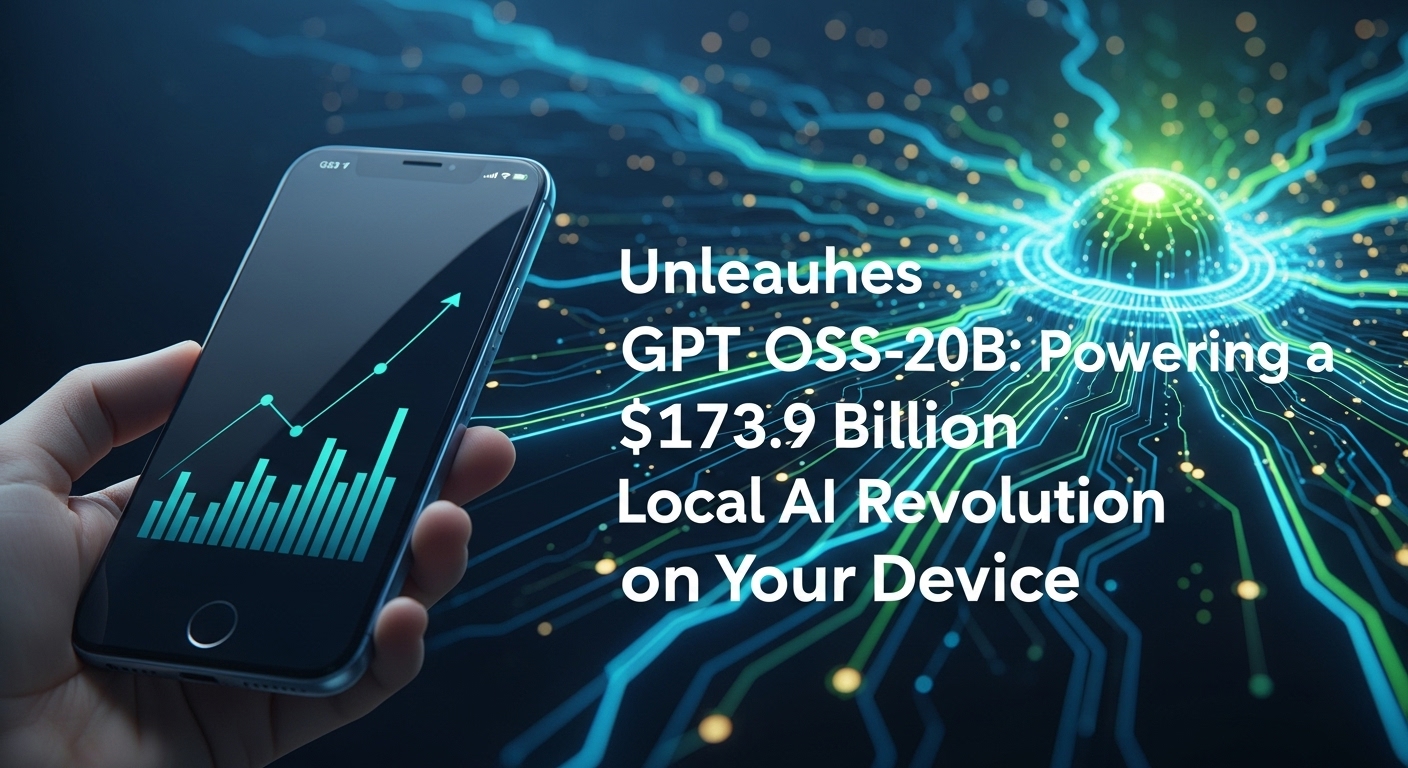【速報】OpenAIがGPT-OSS-20Bを発表!ローカルAIの新時代が到来し、私たちの仕事と生活はどう変わるのか?
AIの進化はとどまることを知りませんが、この度OpenAIが発表したオープンウェイトモデル「GPT-OSS-20B」は、私たちのAI活用における常識を根底から覆す可能性を秘めています。これは単なる新モデルのリリースに留まらず、AIの民主化を加速させ、これまでクラウドAIに依存してきた様々な課題を一挙に解決する画期的な一歩となるでしょう。今回は、GPT-OSS-20BがもたらすローカルAI活用の未来と、それが私たちの仕事、そして日常生活に与える影響について深く掘り下げていきます。
OpenAIの新たな挑戦:GPT-OSS-20Bとは何か?
OpenAIが突如発表した「GPT-OSS-20B」は、パラメータ数200億という強力な性能を持ちながら、そのモデルウェイトがオープンにされるという点で既存のクローズドモデルとは一線を画します。これは、OpenAIがこれまで培ってきた最先端のAI技術を、より多くの開発者や企業が「手元で」利用し、カスタマイズできる道を開くことを意味します。オープンウェイトモデルとは、モデルの内部構造や学習済みの重み(ウェイト)が公開され、誰でもダウンロードして自身のデバイス上で実行したり、ファインチューニングを施したりできるモデルを指します。 これにより、特定のベンダーに依存することなく、AIモデルを自由に拡張・改良できる環境が提供されるのです。
ローカルAI活用の夜明け:なぜ今、オープンウェイトモデルなのか?
GPT-OSS-20BがローカルAI活用を推進する背景には、いくつかの重要なメリットがあります。
データプライバシーとセキュリティの向上
機密性の高いデータをクラウドに送信する必要がなくなり、企業や個人はデータを自身のデバイス内で安全に処理できるようになります。これにより、データ漏洩のリスクが大幅に低減され、GDPRやCCPAなどの厳格なデータ規制への対応も容易になります。
コスト削減とスケーラビリティ
クラウドAPIの利用料や通信費用を削減し、予測可能なランニングコストでAIを運用できます。特に、頻繁に利用するAIアプリケーションや大規模な処理が必要な場合に、その恩恵は大きいでしょう。また、独自のハードウェア上でAIをスケールさせることも可能になります。
カスタマイズ性とイノベーションの加速
公開されたウェイトを基に、特定の業界や用途に特化したファインチューニングが容易になります。 これにより、医療、金融、製造業など、各分野のニーズに合致した独自のAIソリューションが次々と誕生し、新たなイノベーションが加速することが期待されます。
オフライン環境での利用
インターネット接続が不安定な場所や、完全にオフラインの環境でもAIを利用できるようになります。これは、遠隔地での作業や、セキュリティ要件の厳しい施設での活用において非常に重要な利点となります。
GPT-OSS-20Bが変える未来:仕事と生活への影響
このオープンウェイトモデルの登場は、多岐にわたる分野で革命的な変化をもたらすでしょう。
ビジネス
社内文書の自動要約、顧客サポートのパーソナライズ、データ分析、コンテンツ生成など、AIがよりパーソナルかつセキュアに企業の業務効率を向上させます。中小企業でも高性能なAIを導入しやすくなり、競争力の強化につながる可能性があります。
開発者コミュニティ
AIモデルの内部にアクセスできることで、研究者は新たなアルゴリズムの開発やAIの挙動に関する深い洞察を得られます。開発者はモデルを自由に改変し、独自のAIアプリケーションを創造できるようになるため、AIエコシステム全体の活性化に貢献します。
個人ユーザー
個人のデバイス上で動作する高性能なAIアシスタントが実現し、よりパーソナルな学習体験、クリエイティブなコンテンツ生成、スマートホームデバイスとの高度な連携などが可能になります。プライバシーを保護しながら、生活の質を向上させるAIの恩恵を誰もが享受できる時代が近づいています。
課題と展望
もちろん、オープンウェイトモデルの普及には課題も存在します。高性能モデルをローカルで実行するためのハードウェア要件、悪用リスクへの対策、モデルのメンテナンスとアップデートの仕組み作りなどが挙げられます。しかし、これらの課題を克服することで、OpenAIはAIの真の民主化を実現し、誰もがAIの恩恵を享受できる社会を構築しようとしていると言えるでしょう。
GPT-OSS-20Bは、AIが私たちの手元に、より身近な存在となる未来の扉を開きました。このエキサイティングな変化が、私たちの生活やビジネスにどのような革新をもたらすのか、今後の動向に注目せずにはいられません。
OpenAI Unlocks New Horizons: GPT-OSS-20B Drives the On-Device AI Revolution
In a significant strategic pivot that promises to redefine the landscape of artificial intelligence, OpenAI has officially unveiled its groundbreaking open-weight model, GPT-OSS-20B. This announcement marks a bold step towards democratizing advanced AI capabilities, empowering individuals and enterprises to harness sophisticated large language models (LLMs) directly on their local devices. With the on-device AI market projected to skyrocket to an impressive $173.9 billion by 2030, GPT-OSS-20B arrives at a pivotal moment, ushering in an era of enhanced privacy, reduced latency, and unparalleled control over AI applications.
What is OpenAI’s GPT-OSS-20B? A Closer Look at the Open-Weight Paradigm
GPT-OSS-20B is OpenAI’s latest entry into the rapidly expanding ecosystem of open-weight AI models. Unlike fully open-source models that share both training code and data, open-weight models, such as GPT-OSS-20B, make the trained “engine” – the model weights – publicly accessible under a permissive Apache 2.0 license. This crucial distinction allows developers and businesses to download, adapt, and deploy the model commercially on their own machines or private cloud infrastructure, offering a remarkable degree of control without revealing OpenAI’s proprietary training methodologies.
The “20B” in its name signifies 20 billion parameters, a sweet spot that makes it efficient enough to run on consumer-grade hardware, including standard laptops and even modern MacBooks. Despite its relatively compact size, GPT-OSS-20B boasts performance comparable to OpenAI’s highly regarded o3-mini models for demanding tasks like coding and complex reasoning. This balance of capability and accessibility is what truly sets GPT-OSS-20B apart, making advanced AI inference a tangible reality for a broader audience.
The Irresistible Appeal of Local AI: Why Now is the Time
The push towards local AI, also known as edge AI, isn’t a new concept, but several converging factors have made its necessity more pronounced than ever. Businesses and individual users are increasingly seeking alternatives to purely cloud-based AI solutions, driven by critical concerns that local deployment effectively addresses:
- Unmatched Data Privacy and Security: One of the most compelling reasons for local AI is the imperative to keep sensitive data in-house. When AI models run on local devices, data never leaves the user’s control, significantly reducing exposure to third-party servers, potential breaches, and the complexities of data sovereignty and regulatory compliance like GDPR or HIPAA.
- Reduced Latency and Real-time Performance: Cloud-based AI inevitably introduces latency due to data transmission over networks. For applications requiring instant responses—such as voice assistants, real-time analytics, or autonomous systems—local execution eliminates internet lag, enabling near-instantaneous decision-making.
- Cost Efficiency in the Long Run: While initial hardware investment might be required, running AI locally can lead to substantial cost savings over time by eliminating recurring cloud subscription fees, API call charges, and data transfer costs. This makes it an attractive option for high-frequency use cases or large-scale deployments.
- Reliable Offline Functionality: The ability to operate without a constant internet connection is a game-changer for many scenarios, from remote work and travel to applications in areas with limited connectivity. Local AI ensures uninterrupted access to powerful tools and insights, enhancing reliability and versatility.
- Greater Customization and Control: With local models, users gain complete control over fine-tuning and optimization, tailoring the AI to their specific datasets, workflows, and unique needs. This level of customization is often difficult or costly to achieve with proprietary cloud services.
Technical Prowess: How GPT-OSS-20B Achieves On-Device Excellence
OpenAI’s ability to deliver such potent reasoning capabilities within a 20-billion-parameter model, optimized for accessible hardware, is a testament to sophisticated engineering. GPT-OSS-20B leverages an advanced Mixture-of-Experts (MoE) architecture, which allows the model to selectively activate only relevant parts of its neural network for a given task, improving efficiency without sacrificing performance. Furthermore, innovative native quantization techniques were applied during training, enabling the model to operate efficiently with fewer computational resources while preserving accuracy.
OpenAI’s Strategic Masterstroke: A New Frontier in AI Competition
The release of GPT-OSS-20B is more than just a technological advancement; it signifies a calculated strategic maneuver by OpenAI in an increasingly competitive AI landscape. This move represents OpenAI’s most significant pivot towards the open-weight community since GPT-2 in 2019, reflecting a response to the growing prominence of open-source models from rivals like Meta’s Llama series and various Chinese firms.
By offering powerful open-weight models, OpenAI aims to attract a wider developer base and address enterprise demands for privacy and control, effectively pursuing a strategy of “controlled openness.” This dual-pronged approach allows OpenAI to remain a central thought leader, fostering innovation across the entire spectrum of AI development while balancing accessibility with its proprietary edge. The Apache 2.0 license further encourages broad adoption and experimentation, aligning with a vision of democratizing AI while maintaining a competitive stance in the global market.
Navigating the Path to Local AI: Challenges and Considerations
While the benefits of local AI are substantial, organizations and developers must also be prepared for certain challenges. Deploying and managing AI models locally often requires more powerful hardware, including dedicated GPUs and sufficient RAM/VRAM, particularly for larger models or intensive tasks. Technical expertise is essential for setup, optimization (like quantization), and ongoing maintenance, which can represent a significant investment in time and resources. Furthermore, while open-weight offers more transparency than closed models, it still differs from full open-source in that the training data and code typically remain undisclosed.
The Hybrid Future: Blending Local and Cloud AI
Looking ahead, the future of AI deployment is increasingly pointing towards a hybrid paradigm that combines the best of both local and cloud worlds. Organizations may leverage cloud infrastructure for training massive models or handling peak demand, while utilizing local AI for sensitive data processing, real-time inference, and scenarios where offline functionality is critical. GPT-OSS-20B’s accessibility makes it an ideal candidate for such hybrid strategies, allowing businesses to build robust, flexible, and privacy-conscious AI solutions.
OpenAI’s release of GPT-OSS-20B is a landmark event that significantly advances the capabilities of local AI. By putting a powerful, open-weight model directly into the hands of developers and businesses, OpenAI is not only responding to the growing demand for privacy and control but is also actively shaping a more decentralized, accessible, and innovative future for artificial intelligence.



